
The principles of building performance in the event of a fire have remained constant for years, with the overarching goal to reduce the risk to people and property if there is a fire. Buildings are designed to allow for safe evacuation, by ensuring there is no premature failure of any element within the building itself, and fire and smoke cannot spread from one compartment to another.
UK construction professionals need to consider how to control or restrict the spread of a fire and maintain the fire resistance of the building. Such fire protection measures can be classified as either active or passive, although good building design will use a mix of technologies.
Active measures include systems which respond to the presence of a fire, including fire detection and alarms, smoke control measures or suppression systems.
Passive measures, also sometimes defined as “built in” fire protection, include materials and systems that make up, or sit in, the fabric of a building to restrict and prevent the spread of fire, and protect the overall building structure. Many building materials, for example bricks and concrete, have a measure of natural resistance to fire. However, natural fire resistance may be enhanced using additional materials to improve or maintain a buildings performance. Unlike active systems, passive fire protection does not require any special energisation or command signal to operate and can be broken down into four main areas.
- Fire protection to the structural frame of the building
- Internal compartmentation
- Building services
- The building envelope
The choice of fire safety materials and systems, including passive fire protection measures have come under greater scrutiny in recent years, driven by the “Independent Review of Building Regulations and Fire Safety”, conducted by Dame Judith Hackitt. There has been a push for improved guidance and regulations for building professionals, requiring:
- Improved overall clarity in existing regulations and guidance
- More accountability for the safety of a building throughout its lifecycle
- Greater focus on compliance and product testing
How do you protect concrete against fire?
Concrete is a major component of many buildings constructed in the UK, both in new developments and renovation projects. While concrete does provide a degree of natural fire resistance, as noted previously, in the event of a fire exposed concrete can experience both mechanical and chemical changes. These include the potential for explosive spalling where portions of concrete delaminate from the surface layer, and external cracking caused by thermal expansion and the dehydration of the concrete – in both cases allowing the direct heating of exposed reinforcing steel (rebar). At temperatures more than 260°C rebar will progressively lose its tensile strength, resulting in the potential structural failure of reinforced concrete.
With this in mind, the need to protect concrete against fire should be a significant element of the fire strategy of a building.
Two effective methods to increase the fire resistance in concrete structures are coatings, for example intumescent paints or sprays, and fire protection boards.

In particular, engineered calcium silicate protection boards are an increasingly popular method for increasing fire resistance in concrete structures. The boards are made of a non-combustible material (A1 when tested to EN13501-1) and offer architects, main contractors, sub-contractors, and other specifiers the option to upgrade structural elements and create internal compartments.
This offers a more flexible approach to internal fit outs or refurbishment projects. Ceilings and partitions can be created easily using the protection boards. And as an added advantage, the boards have a smooth surface to achieve a great finish with paints and standard joint fillers.
Introducing PROMATECT®-H fire protection boards
PROMATECT®-H is a safe, secure, fire-resistant mineral board to protect concrete. It offers tested protection for concrete columns, walls, beams, and slabs.
For architects and main contractors, a big advantage of PROMATECT®-H is that it is easy to specify. Similarly, sub-contractors appreciate the fact the protection boards are easy to install.
But the biggest advantage for construction professionals is the fact that using PROMATECT®-H will ensure that a building’s concrete elements comply with all existing fire regulations and UK Building Regulations.

The benefits of PROMATECT®-H fire protection boards
- Tested to EN 13381-3:2015, PROMATECT® -H can, in the event of a fire, protect load-bearing concrete elements from 30 to 240 minutes.
- PROMATECT®-H can be used on new build and renovation projects.
- Off-white in colour with a smooth finish on one side and a sanded reverse, PROMATECT®-H boards can be left undecorated or finished using paint, wallpaper, or tiles. This provides the opportunity for aesthetic upgrading if required.
- With a resistance to moisture, PROMATECT®-H won’t deteriorate when used in damp or humid conditions. This means it can be installed and left semi-exposed so it can be brought into the construction schedule at an early stage, making the build process faster.
- At just 12mm or 25mm, PROMATECT®-H is a slim board so has minimal impact on the overall dimensions of a building. Being available in two thicknesses also means PROMATECT®-H covers the full range of applications and fire resistance periods.
More information on PROMATECT®-H
For more information on PROMATECT®-H boards and other Promat passive fire protection products, [For more information on PROMATECT®-H boards and other Promat passive fire protection products, get in touch with the Promat team.

